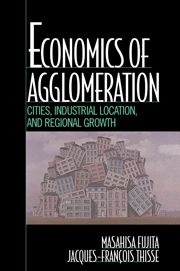Book contents
- Frontmatter
- Contents
- Acknowledgments
- 1 Agglomeration and Economic Theory
- PART I FUNDAMENTALS OF GEOGRAPHICAL ECONOMICS
- PART II THE STRUCTURE OF METROPOLITAN AREAS
- PART III FACTOR MOBILITY AND INDUSTRIAL LOCATION
- PART IV URBAN SYSTEMS AND REGIONAL GROWTH
- 10 Back to Thünen
- 11 On the Relationship between Agglomeration and Growth
- References
- Name Index
- Subject Index
11 - On the Relationship between Agglomeration and Growth
Published online by Cambridge University Press: 05 June 2012
- Frontmatter
- Contents
- Acknowledgments
- 1 Agglomeration and Economic Theory
- PART I FUNDAMENTALS OF GEOGRAPHICAL ECONOMICS
- PART II THE STRUCTURE OF METROPOLITAN AREAS
- PART III FACTOR MOBILITY AND INDUSTRIAL LOCATION
- PART IV URBAN SYSTEMS AND REGIONAL GROWTH
- 10 Back to Thünen
- 11 On the Relationship between Agglomeration and Growth
- References
- Name Index
- Subject Index
Summary
INTRODUCTION
The likely main effect of interregional and international integration is to increase economic efficiency within the space-economy. However, as seen in Chapter 9, market expansion may well be accompanied by the development of some core regions whose wealth is, in part, obtained at the expense of peripheral regions: the average welfare in the region accommodating the modern sector rises but decreases in the other region. So far, however, such a result has been obtained using static models in which the total number of firms and varieties, which is determined by the parameters of the economy, is constant. It is, therefore, of fundamental importance to determine what the core–periphery property becomes in a dynamic setting in which the number of firms grows over time. In other words, we want to deal with the following question: How do growth and location affect each other? More precisely, we want to know whether regional discrepancies widen or fall over time, as well as the main reasons for such a possible divergence or convergence. Because in the context of human history, the current disparities between rich and poor regions are recent (Bairoch 1993, chap. 9), it is important to understand how they may change over time. Regional discrepancies are often considered socially undesirable, and the issue is consequently critical from the policy standpoint. If compelling evidence is found that the existing disparities are likely to persist or, worse, that growth and agglomeration will make those living in the periphery worse off, then governments and international bodies should become more active in designing policies to foster a more equitable distribution of wealth across nations and regions.
- Type
- Chapter
- Information
- Economics of AgglomerationCities, Industrial Location, and Regional Growth, pp. 388 - 432Publisher: Cambridge University PressPrint publication year: 2002
- 6
- Cited by



